LoRaWAN and Urban Waste Management—A Trial
Abstract
1. Introduction
- LoRaWAN (Low Range Wide Area Network)—the complementary network layer to the LoRa technology, which, by itself, only specifies the physical layer of the communications stack. This technology will be described in Section 2;
- Sigfox—an alternative network with the same aim, based on a closed business model, in which the network is always supported by an operator, also called Sigfox. This is the key difference to other technologies, there is only one operator;
- NB-IoT (Narrow Band IoT)—technology supported by public mobile communications networks, resulting from an evolution of the widely deployed LTE (Long-Term Evolution) technology. NB-IoT is the most recent IoT technology, its operating model is based on the conventional models of public mobile operators, based on a subscription.
1.1. Purpose
1.2. Organization of the Document
2. LoRa Technology—Long Range
2.1. LoRa
2.2. LoRaWAN
- The sensor device, usually with energy and computational limitations;
- The gateway, a network element that receives and transmits data from and to devices;
- The network server, which forwards messages received by a set of gateways to the applications and vice versa;
- The application, somewhere on the Internet, that receives and sends data to the sensors through the network server.
3. Related Work
4. Trials
- Radio coverage, ensuring LoRa provides the coverage levels required to monitor waste containers installed on the surface and underground;
- Capacity, validating whether the capacity offered by the network for data transmission is sufficient to satisfy the need for the application in question.
4.1. Network Deployment
4.2. Sensors
- IoTsens Waste Sensor, high-end sensor, with quality specifications and higher costs (€300);
- Dingtek DF702, sensor with lower specifications, also corresponding to lower costs (€70).
4.2.1. IoTsens Waste Sensor
4.2.2. Dingtek DF702
4.2.3. Sensor Deployment
4.3. Use Cases
5. Evaluation
5.1. Radio Coverage
5.2. Deployment Conditions Impact
| Algorithm 1 Network Probe |
| Input: Datarates and Payloads to be tested |
| Output: Perceived RSSI (Received signal strength indication) of each message |
| 1: initialize radio at device |
| 2: initialize application connected to TTN |
| 3: for each payload in payloads[] do |
| 4: for each datarate in datarates[] do |
| 5: set datarate |
| 6: send payload |
| 7: sleep in order to comply with the duty cycle |
| 8: collect RSSI values from application |
5.2.1. Iglô
5.2.2. Underground Container
6. Conclusions
- Capacity, where it was possible to confirm that the capacity offered by technology for data transmission is sufficient to satisfy the need for the application in question, even in unfavorable conditions, which imply a lower transmission rate;
- Radio coverage, showing the feasibility of using LoRa technology to support communication with sensors installed inside the different types of containers. This possibility was validated in the most unfavorable situation, namely in underground containers, with additional attenuations, associated with the penetration of the radio signal.
Author Contributions
Funding
Institutional Review Board Statement
Informed Consent Statement
Data Availability Statement
Conflicts of Interest
References
- Foubert, B.; Mitton, N. Long-Range Wireless Radio Technologies: A Survey. Future Internet 2020, 12, 13. [Google Scholar] [CrossRef]
- Sornin, N.; Yegin, Y. LoRaWANTM 1.1 Specification. Lora Alliance 2017, 10. Available online: https://lora-alliance.org/wp-content/uploads/2020/11/lorawantm_specification_-v1.1.pdf (accessed on 10 March 2021).
- Application Note #AN1200.22 LoRaTM Modulation Basics, Rev. 2. Semtech. 2015. Available online: https://lora-developers.semtech.com/library/product-documents/ (accessed on 10 March 2021).
- LoRa SX1276/77/78/79 Datasheet, Rev. 7. Semtech. May 2020. Available online: http://www.semtech.com (accessed on 10 March 2021).
- Andrade, R.O.; Yoo, S.G. A Comprehensive Study of the Use of LoRa in the Development of Smart Cities. Appl. Sci. 2019, 9, 4753. [Google Scholar] [CrossRef]
- Cerchecci, M.; Luti, F.; Mecocci, A.; Parrino, S.; Peruzzi, G.; Pozzebon, A. A Low Power IoT Sensor Node Architecture for Waste Management Within Smart Cities Context. Sensors 2018, 18, 1282. [Google Scholar] [CrossRef]
- Zavare, S.; Parashare, R.; Patil, S.; Rathod, P.; Babanne, V. Smart City Waste Management System Using GSM. Int. J. Comput. Sci. Trends Technol. IJCST 2017, 5, 74–78. [Google Scholar]
- Lokhande, P.; Pawar, M.D. A Review: Garbage Collection Management System. Int. J. Res. Eng. Technol. 2016, 5, 79–82. [Google Scholar]
- Gutierrez, J.M.; Jensen, M.; Henius, M.; Riaz, T. Smart Waste Collection System Based on Location Intelligence. Procedia Comput. Sci. 2015, 61, 120–127. [Google Scholar] [CrossRef]
- Medvedev, A.; Fedchenkov, P.; Zaslavsky, A.; Anagnostopoulos, T.; Khoruzhnikov, S. Waste Management as an IoT-Enabled Service in Smart Cities. In Internet of Things, Smart Spaces, and Next Generation Networks and Systems; Balandin, S., Andreev, S., Koucheryavy, Y., Eds.; Springer International Publishing: Cham, Switzerland, 2015; pp. 104–115. [Google Scholar]
- Asimakopoulos, G.; Christodoulou, S.; Gizas, A.; Triantafillou, V.; Tzimas, G.; Viennas, E.; Papalambrou, A. Towards a dynamic waste collection management system using real-time and forecasted data. In Proceedings of the 16th International Conference on Engineering Applications of Neural Networks (INNS), Rhodes, Greece, 25–28 September 2015; p. 36. [Google Scholar]
- Narendra Kumar, G.; Swamy, C.; Nagadarshini, K.N. Efficient garbage disposal management in metropolitan cities using VANETs. J. Clean Energy Technolies 2014, 2, 258–262. [Google Scholar] [CrossRef]
- Longhi, S.; Marzioni, D.; Alidori, E.; Buo, G.D.; Prist, M.; Grisostomi, M.; Pirro, M. Solid Waste Management Architecture Using Wireless Sensor Network Technology. In Proceedings of the 2012 5th International Conference on New Technologies, Mobility and Security (NTMS), Istanbul, Turkey, 7–10 May 2012; pp. 1–5. [Google Scholar]
- Lozano, Á.; Caridad, J.; De Paz, J.F.; Villarrubia González, G.; Bajo, J. Smart Waste Collection System with Low Consumption LoRaWAN Nodes and Route Optimization. Sensors 2018, 18, 1465. [Google Scholar] [CrossRef]
- Catania, V.; Ventura, D. An Approach for Monitoring and Smart Planning of Urban Solid Waste Management Using Smart-M3 Platform. In Proceedings of the 15th Conference of Open Innovations Association FRUCT, St. Petersburg, Russia, 21–25 April 2014; pp. 24–31. [Google Scholar]
- Hong, I.; Park, S.; Lee, B.; Lee, J.; Jeong, D.; Park, S. IoT-Based Smart Garbage System for Efficient Food Waste Management. Sci. World J. 2014, 2014, 646953. [Google Scholar] [CrossRef]
- Shafiq, M.; Ashraf, H.; Ullah, A.; Tahira, S. Systematic Literature Review on Energy Efficient Routing Schemes in WSN—A Survey. Mob. Netw. Appl. 2020, 25, 882–895. [Google Scholar] [CrossRef]
- Adu-Manu, K.S.; Adam, N.; Tapparello, C.; Ayatollahi, H.; Heinzelman, W. Energy-Harvesting Wireless Sensor Networks (EH-WSNs): A Review. ACM Trans. Sens. Netw. 2018, 14, 10:1–10:50. [Google Scholar] [CrossRef]
- Muzakkari, B.; Mohamed, M.A.; Mohamad, Z.; Jamil, N.; Abdul Kadir, M.F. Recent Advances in Energy Efficient-QoS Aware MAC Protocols for Wireless Sensor Network. Int. J. Adv. Comput. Res. 2018, 8, 212–228. [Google Scholar] [CrossRef]
- Fei, Z.; Li, B.; Yang, S.; Xing, C.; Chen, H.; Hanzo, L. A Survey of Multi-Objective Optimization in Wireless Sensor Networks: Metrics, Algorithms, and Open Problems. IEEE Commun. Surv. Tutor. 2017, 19, 550–586. [Google Scholar] [CrossRef]
- Chen, Y.; Lv, X.; Lu, S.; Ren, T. A Lifetime Optimization Algorithm Limited by Data Transmission Delay and Hops for Mobile Sink-Based Wireless Sensor Networks. J. Sens. 2017, 2017, 7507625. [Google Scholar] [CrossRef]
- Idrees, A.K.; Deschinkel, K.; Salomon, M.; Couturier, R. Perimeter-Based Coverage Optimization to Improve Lifetime in Wireless Sensor Networks. Eng. Optim. 2016, 48, 1951–1972. [Google Scholar] [CrossRef]
- Iqbal, M.; Naeem, M.; Anpalagan, A.; Ahmed, A.; Azam, M. Wireless Sensor Network Optimization: Multi-Objective Paradigm. Sensors 2015, 15, 17572–17620. [Google Scholar] [CrossRef]
- Mao, Y.; Cheng, D. An Energy-Efficent Routing Protocol for WSN-Based Intelligent Mining System. In Proceedings of the 2014 9th International Conference on Computer Science Education, Vancouver, BC, Canada, 22–24 August 2014; pp. 973–976. [Google Scholar]
- Wu, Y.; Liu, W. Routing Protocol Based on Genetic Algorithm for Energy Harvesting-Wireless Sensor Networks. IET Wirel. Sens. Syst. 2013, 3, 112–118. [Google Scholar] [CrossRef]
- Pinto, A.R.; Poehls, L.B.; Montez, C.; Vargas, F. Power Optimization for Wireless Sensor Networks. Wirel. Sens. Netw. Technol. Appl. 2012. [Google Scholar] [CrossRef]
- Soua, R.; Minet, P. A Survey on Energy Efficient Techniques in Wireless Sensor Networks. In Proceedings of the 2011 4th Joint IFIP Wireless and Mobile Networking Conference (WMNC 2011), Toulouse, France, 26–28 October 2011; pp. 1–9. [Google Scholar]
- Sahoo, A.; Chilukuri, S. DGRAM: A Delay Guaranteed Routing and MAC Protocol for Wireless Sensor Networks. IEEE Trans. Mob. Comput. 2010, 9, 1407–1423. [Google Scholar] [CrossRef]
- Ban-Teng, L.; You-Rong, C.; Kai, Z.; Hua, J. The research of Wireless Sensor Networks optimization algorithm based on the energy control. In Proceedings of the 2010 Third International Symposium on Information Processing (ISIP), Qingdao, China, 15–17 October 2010; pp. 420–422. [Google Scholar]
- Bachir, A.; Heusse, M.; Duda, A.; Leung, K.K. Preamble Sampling MAC Protocols with Persistent Receivers in Wireless Sensor Networks. IEEE Trans. Wirel. Commun. 2009, 8, 1091–1095. [Google Scholar] [CrossRef]
- Jiang, H.; Qian, J.; Peng, W. Energy Efficient Sensor Placement for Tunnel Wireless Sensor Network in Underground Mine. In Proceedings of the 2009 2nd International Conference on Power Electronics and Intelligent Transportation System (PEITS), Shenzhen, China, 19–20 December 2009; Volume 2, pp. 219–222. [Google Scholar]
- Alippi, C.; Anastasi, G.; Francesco, M.D.; Roveri, M. Energy Management in Wireless Sensor Networks with Energy-Hungry Sensors. IEEE Instrum. Meas. Mag. 2009, 12, 16–23. [Google Scholar] [CrossRef]
- Chen, G.; Zhu, Z.; Zhou, G.; Shen, C.; Sun, Y. Sensor Deployment Strategy for Chain-Type Wireless Underground Mine Sensor Network. J. China Univ. Min. Technol. 2008, 18, 561–566. [Google Scholar] [CrossRef]
- Vigorito, C.M.; Ganesan, D.; Barto, A.G. Adaptive Control of Duty Cycling in Energy-Harvesting Wireless Sensor Networks. In Proceedings of the 2007 4th Annual IEEE Communications Society Conference on Sensor, Mesh and Ad Hoc Communications and Networks, San Diego, CA, USA, 18–21 June 2007; pp. 21–30. [Google Scholar]
- Lu, G.; Krishnamachari, B.; Raghavendra, C.S. An Adaptive Energy-Efficient and Low-Latency MAC for Tree-Based Data Gathering in Sensor Networks. Wirel. Commun. Mob. Comput. 2007, 7, 863–875. [Google Scholar] [CrossRef]
- Raghunathan, V.; Ganeriwal, S.; Srivastava, M. Emerging Techniques for Long Lived Wireless Sensor Networks. IEEE Commun. Mag. 2006, 44, 108–114. [Google Scholar] [CrossRef]
- Rajendran, V.; Obraczka, K.; Garcia-Luna-Aceves, J.J. Energy-Efficient Collision-Free Medium Access Control for Wireless Sensor Networks. In Proceedings of the 1st International Conference on Embedded Networked Sensor Systems, Los Angeles, CA, USA, 5–7 November 2003; Association for Computing Machinery: New York, NY, USA, 2003; pp. 181–192. [Google Scholar]
- Cardei, M.; Thai, M.T.; Li, Y.; Wu, W. Energy-Efficient Target Coverage in Wireless Sensor Networks. In Proceedings of the IEEE 24th Annual Joint Conference of the IEEE Computer and Communications Societies, Miami, FL, USA, 13–17 March 2005; Volume 3, pp. 1976–1984. [Google Scholar]
- Muruganathan, S.D.; Ma, D.C.F.; Bhasin, R.I.; Fapojuwo, A.O. A Centralized Energy-Efficient Routing Protocol for Wireless Sensor Networks. IEEE Commun. Mag. 2005, 43, S8–S13. [Google Scholar] [CrossRef]
- Younis, O.; Fahmy, S. HEED: A Hybrid, Energy-Efficient, Distributed Clustering Approach for Ad Hoc Sensor Networks. IEEE Trans. Mob. Comput. 2004, 3, 366–379. [Google Scholar] [CrossRef]
- Lu, G.; Krishnamachari, B.; Raghavendra, C.S. An Adaptive Energy-Efficient and Low-Latency MAC for Data Gathering in Wireless Sensor Networks. In Proceedings of the 18th International Parallel and Distributed Processing Symposium, Santa Fe, NM, USA, 26–30 April 2004; pp. 224–231. [Google Scholar]
- Van Dam, T.; Langendoen, K. An Adaptive Energy-Efficient MAC Protocol for Wireless Sensor Networks. In Proceedings of the 1st International Conference on Embedded Networked Sensor Systems, Los Angeles, CA, USA, 5–7 November 2003; Association for Computing Machinery: New York, NY, USA, 2003; pp. 171–180. [Google Scholar]
- Gandham, S.R.; Dawande, M.; Prakash, R.; Venkatesan, S. Energy Efficient Schemes for Wireless Sensor Networks with Multiple Mobile Base Stations. In Proceedings of the GLOBECOM ’03. IEEE Global Telecommunications Conference (IEEE Cat. No.03CH37489), San Francisco, CA, USA, 1–5 December 2003; Volume 1, pp. 377–381. [Google Scholar]
- Ye, W.; Heidemann, J.; Estrin, D. An energy-efficient MAC protocol for wireless sensor networks. In Proceedings of the Twenty-First Annual Joint Conference of the IEEE Computer and Communications Societies (INFOCOM 2002), New York, NY, USA, 23–27 June 2002; Volume 3, pp. 1567–1576. [Google Scholar]
- Schurgers, C.; Tsiatsis, V.; Srivastava, M.B. STEM: Topology Management for Energy Efficient Sensor Networks. In Proceedings of the Proceedings, IEEE Aerospace Conference, Big Sky, MT, USA, 9–16 March 2002; Volume 3, pp. 1099–1108. [Google Scholar]
- Ganesan, D.; Govindan, R.; Shenker, S.; Estrin, D. Highly-Resilient, Energy-Efficient Multipath Routing in Wireless Sensor Networks. Sigmobile Mob. Comput. Commun. Rev. 2001, 5, 11–25. [Google Scholar] [CrossRef]
- Rahman, M.N.; Matin, M.A. Efficient Algorithm for Prolonging Network Lifetime of Wireless Sensor Networks. Tsinghua Sci. Technol. 2011, 16, 561–568. [Google Scholar] [CrossRef]
- Schurgers, C.; Srivastava, M.B. Energy Efficient Routing in Wireless Sensor Networks. In Proceedings of the 2001 MILCOM Proceedings Communications for Network-Centric Operations: Creating the Information Force (Cat. No.01CH37277), McLean, VA, USA, 28–31 October 2001; Volume 1, pp. 357–361. [Google Scholar]
- Manjeshwar, A.; Agrawal, D.P. TEEN: A Routing Protocol for Enhanced Efficiency in Wireless Sensor Networks. In Proceedings of the 15th International Parallel and Distributed Processing Symposium. IPDPS 2001, San Francisco, CA, USA, 23–27 April 2001; pp. 2009–2015. [Google Scholar]
- Heinzelman, W.R.; Chandrakasan, A.; Balakrishnan, H. Energy-efficient communication protocol for wireless microsensor networks. In Proceedings of the 33rd Annual Hawaii International Conference on System Sciences, Maui, HI, USA, 7 January 2000; Volume 2, p. 10. [Google Scholar]
- Beliatis, M.J.; Mansour, H.; Nagy, S.; Aagaard, A.; Presser, M. Digital Waste Management Using LoRa Network a Business Case from Lab to Fab. In Proceedings of the 2018 Global Internet of Things Summit (GIoTS), Bilbao, Spain, 4–7 June 2018; pp. 1–6. [Google Scholar]
- Melakessou, F.; Kugener, P.; Alnaffakh, N.; Faye, S.; Khadraoui, D. Heterogeneous Sensing Data Analysis for Commercial Waste Collection. Sensors 2020, 20, 978. [Google Scholar] [CrossRef] [PubMed]
- Municipal Waste Statistics—Statistics Explained. Available online: https://ec.europa.eu/eurostat/statistics-explained/index.php/Municipal_waste_statistics (accessed on 2 March 2021).
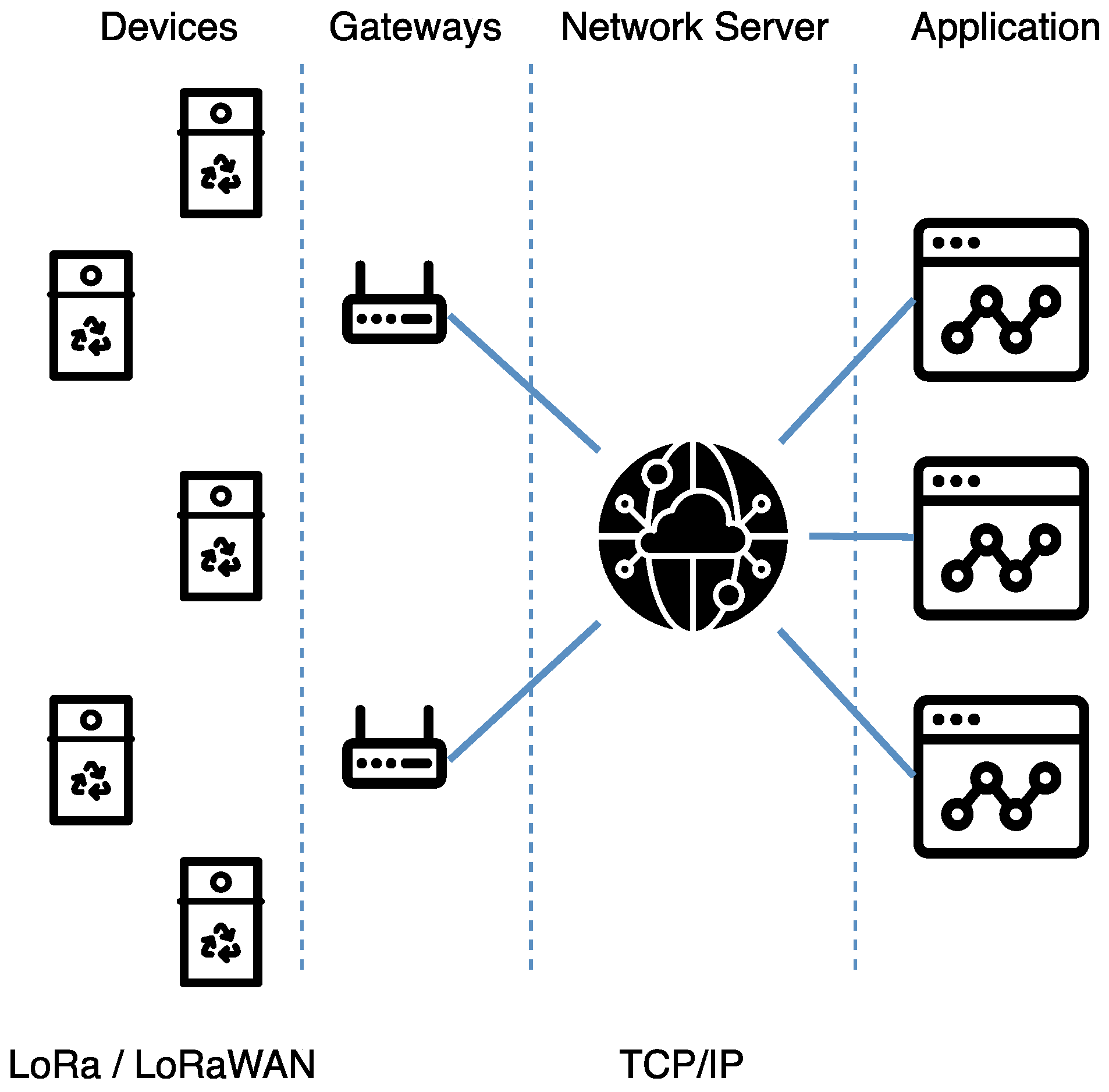
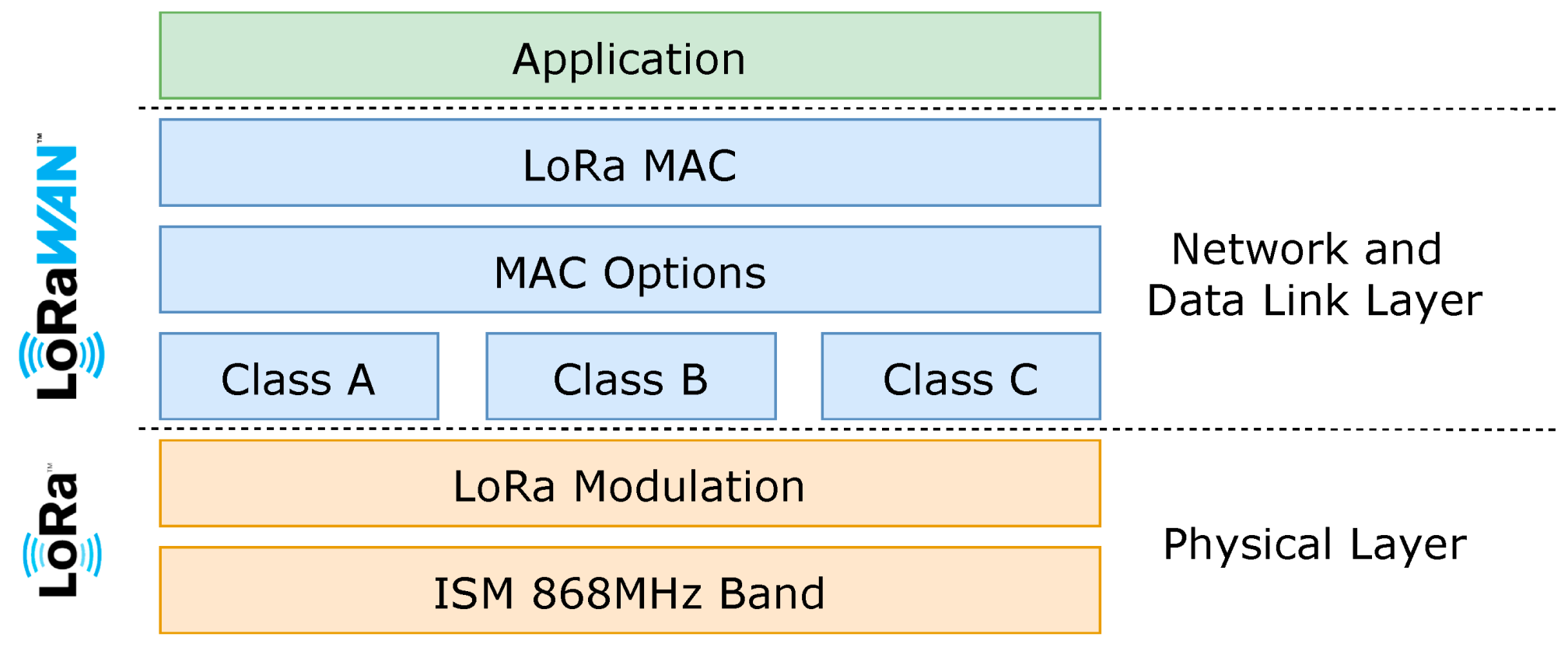

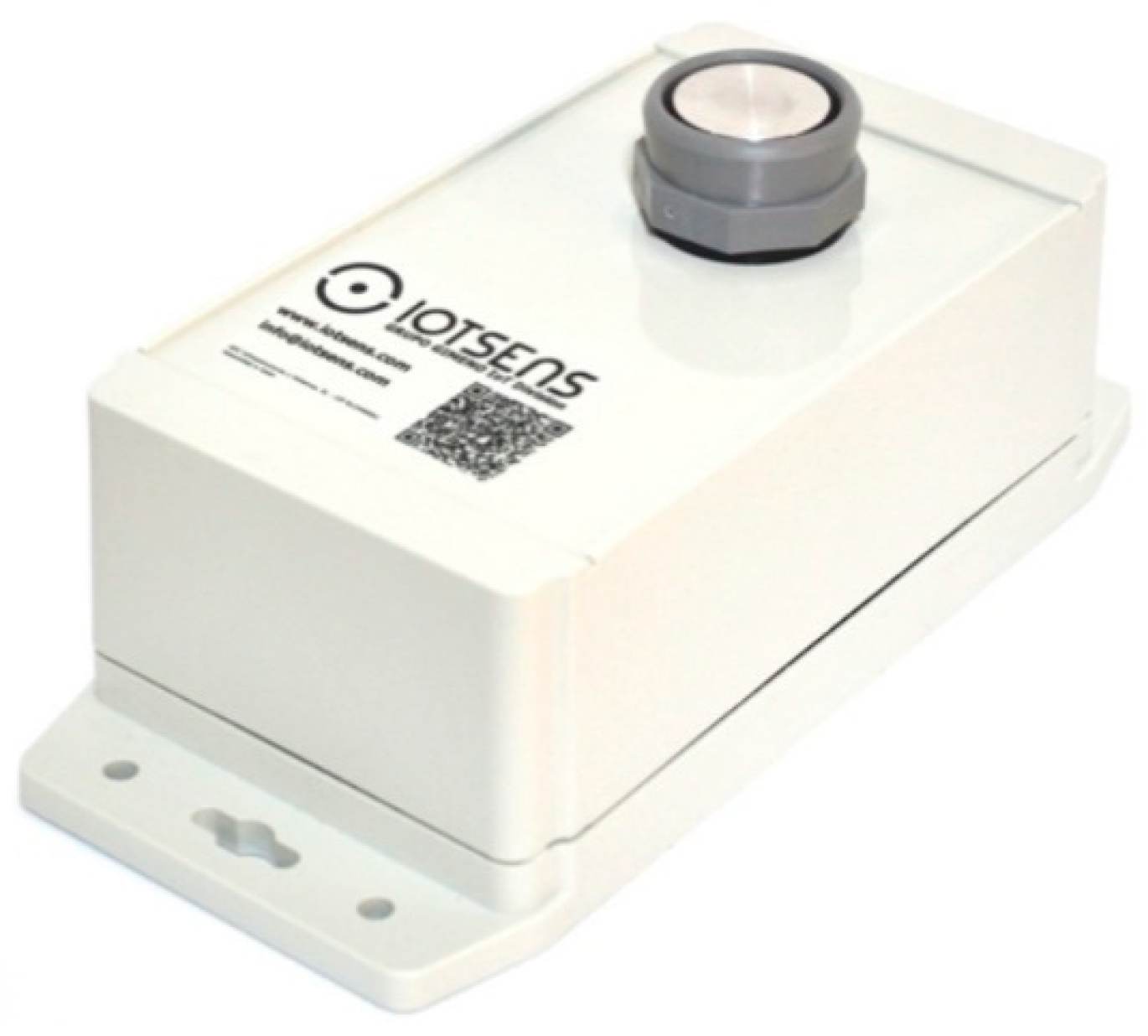
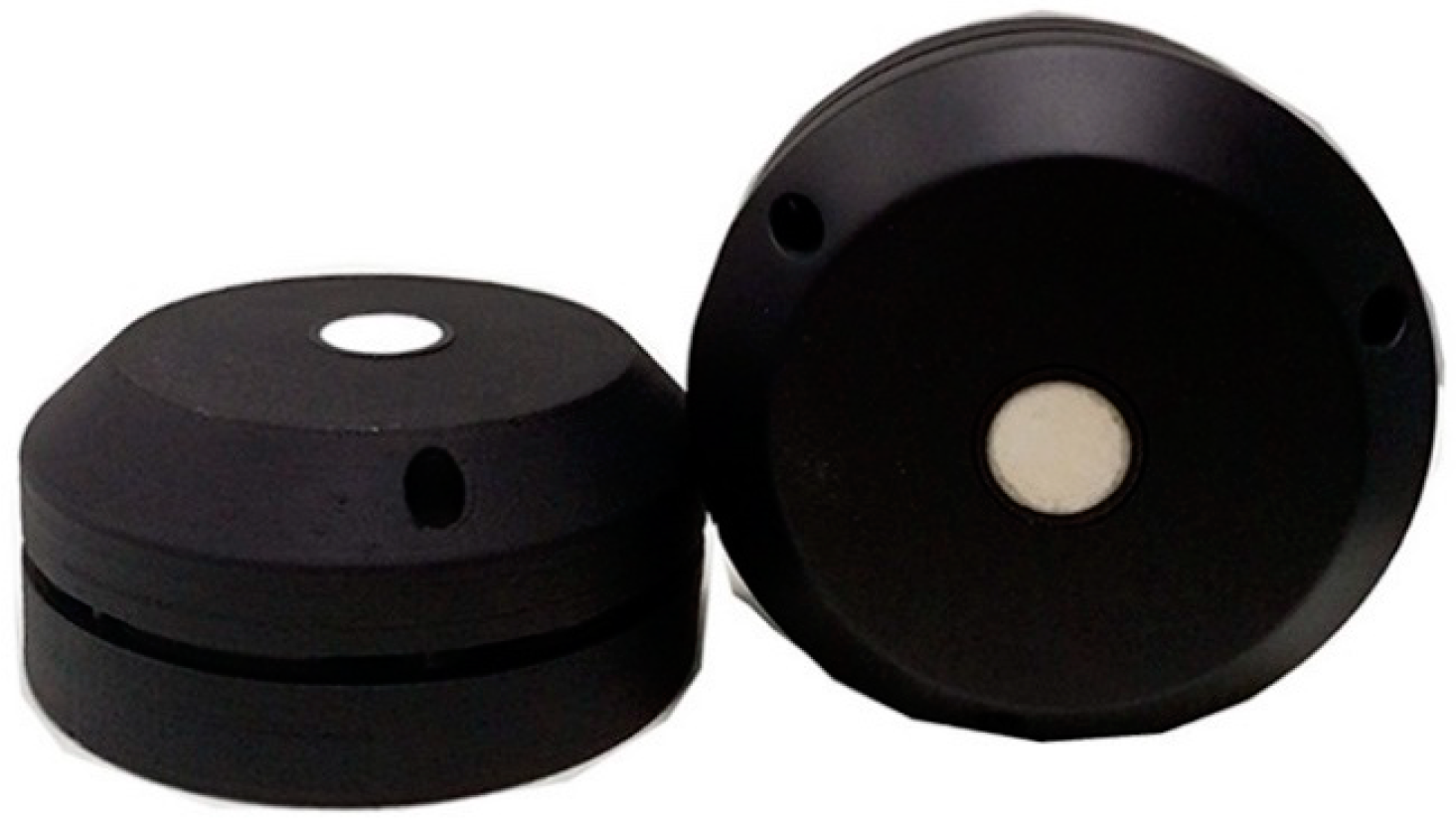


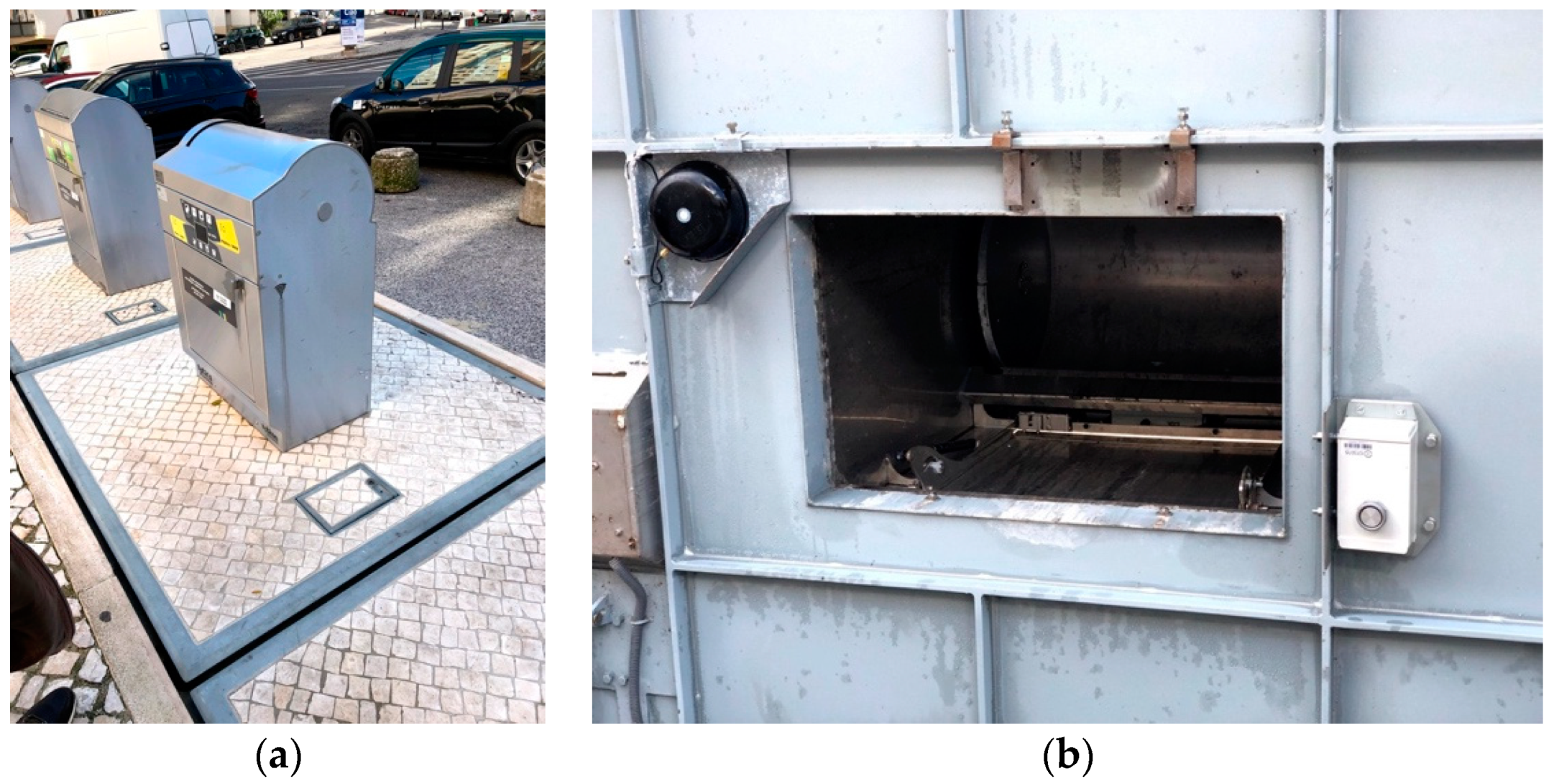
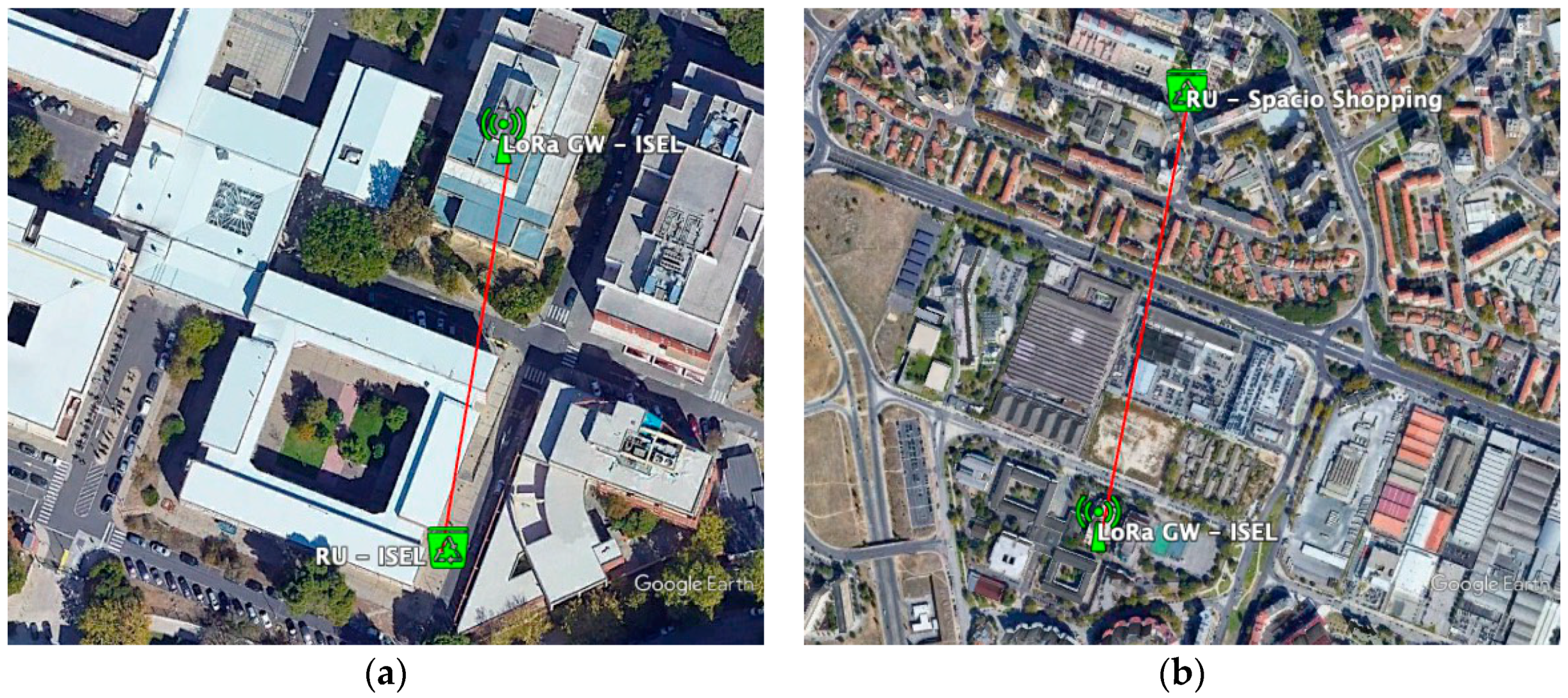
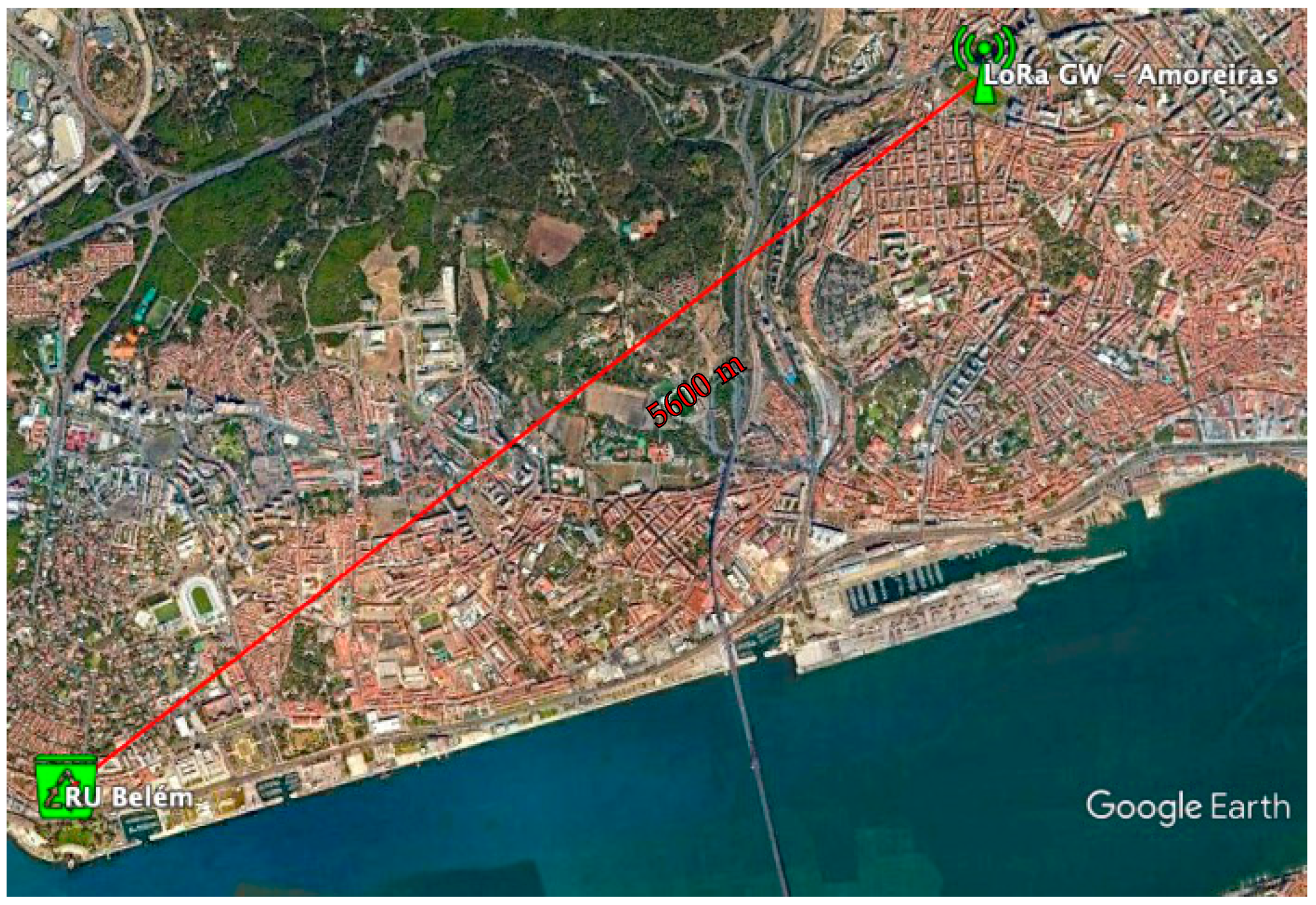




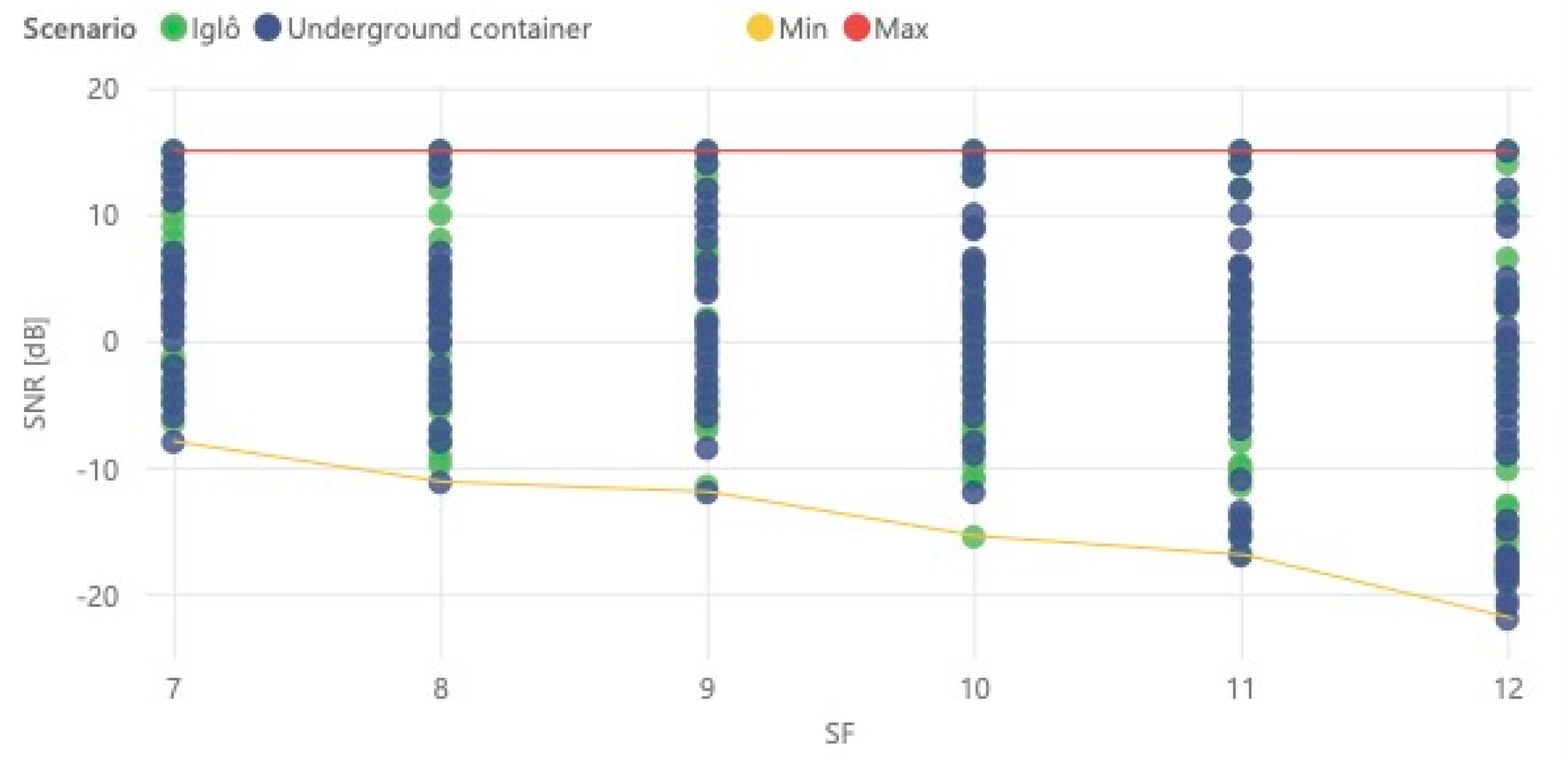



| Location | Model | Antennas | GNSS Position | Altitude |
|---|---|---|---|---|
| ISEL | Cisco IXM-LPWA-800-16-K9 | 2 | N38°45′22.7″ W9°06′57.3″ | 100 m |
| Amoreiras | Lorix One | 1 | N38°43′24.0″ W9°09′47.5″ | 175 m |
| Scenario | RSSI Value (dBm) | Probe Message Count | |||
|---|---|---|---|---|---|
| Min | Max | Avg | StdDev | ||
| Iglô full | |||||
| Inside | −91 | −66 | −73.75 | 5.18 | 60 |
| Outside | −83 | −65 | −71.82 | 3.69 | 60 |
| Difference | −8 | −1 | −1.93 | ||
| Iglô empty | |||||
| Inside | −85 | −62 | −70.07 | 5.18 | 59 |
| Outside | −72 | −59 | −63.98 | 3.38 | 59 |
| Difference | −13 | −3 | −6.09 | ||
| Scenario | RSSI Value (dBm) | Probe Message Count | |||
|---|---|---|---|---|---|
| Min | Max | Avg | StdDev | ||
| Underground Container | |||||
| Inside | −127 | −111 | −121.31 | 2.32 | 49 |
| Outside | −115 | −87 | −94.90 | 6.29 | 59 |
| Difference | −12 | −24 | −26.41 | ||
Publisher’s Note: MDPI stays neutral with regard to jurisdictional claims in published maps and institutional affiliations. |
© 2021 by the authors. Licensee MDPI, Basel, Switzerland. This article is an open access article distributed under the terms and conditions of the Creative Commons Attribution (CC BY) license (http://creativecommons.org/licenses/by/4.0/).
Share and Cite
Cruz, N.; Cota, N.; Tremoceiro, J. LoRaWAN and Urban Waste Management—A Trial. Sensors 2021, 21, 2142. https://doi.org/10.3390/s21062142
Cruz N, Cota N, Tremoceiro J. LoRaWAN and Urban Waste Management—A Trial. Sensors. 2021; 21(6):2142. https://doi.org/10.3390/s21062142
Chicago/Turabian StyleCruz, Nuno, Nuno Cota, and João Tremoceiro. 2021. "LoRaWAN and Urban Waste Management—A Trial" Sensors 21, no. 6: 2142. https://doi.org/10.3390/s21062142
APA StyleCruz, N., Cota, N., & Tremoceiro, J. (2021). LoRaWAN and Urban Waste Management—A Trial. Sensors, 21(6), 2142. https://doi.org/10.3390/s21062142







